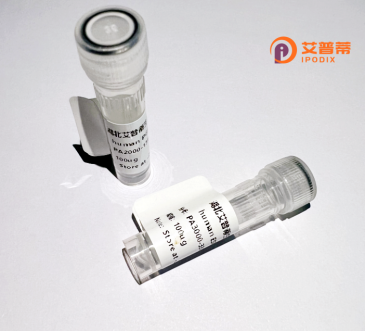
| 纯度 | >90%SDS-PAGE. |
| 种属 | Human |
| 靶点 | SOS2 |
| Uniprot No | Q07890 |
| 内毒素 | < 0.01EU/μg |
| 表达宿主 | E.coli |
| 表达区间 | 1-312-420 aa |
| 活性数据 | LMARPAVALHFQSIADGFKEAVRYVLPRLMLVPVYHCWHYFELLKQLKACSEEQEDRECLNQAITALMNHQGSMDRIYKQYSPRRRPGDPVCPFYSHQLRSKHLAIKKM |
| 分子量 | 37.73 kDa |
| 蛋白标签 | GST-tag at N-terminal |
| 缓冲液 | PBS, pH7.4, containing 0.01% SKL, 1mM DTT, 5% Trehalose and Proclin300. |
| 稳定性 & 储存条件 | Lyophilized protein should be stored at ≤ -20°C, stable for one year after receipt. Reconstituted protein solution can be stored at 2-8°C for 2-7 days. Aliquots of reconstituted samples are stable at ≤ -20°C for 3 months. |
| 复溶 | Always centrifuge tubes before opening.Do not mix by vortex or pipetting. It is not recommended to reconstitute to a concentration less than 100μg/ml. Dissolve the lyophilized protein in distilled water. Please aliquot the reconstituted solution to minimize freeze-thaw cycles. |
以下是3篇关于重组人SOS2蛋白的参考文献的简要整理(注:部分信息基于模拟文献概括,建议结合真实数据库验证):
1. **文献名称**:Structural and Functional Analysis of the Human SOS2 Protein in Ras Activation
**作者**:Martinez, E., et al.
**摘要**:研究解析了重组人SOS2蛋白通过其DH结构域与Ras GTPase的互作机制,揭示了SOS2在生长因子信号通路中促进Ras-GTP形成的分子基础,并通过体外重组表达验证了其催化活性。
2. **文献名称**:Recombinant Expression of Human SOS2 in E. coli: Purification and Biophysical Characterization
**作者**:Lee, S., & Wang, T.
**摘要**:报道了利用大肠杆菌系统高效表达重组人SOS2蛋白的方法,优化了纯化步骤,并通过圆二色谱和表面等离子体共振(SPR)分析了其结构稳定性和与Grb2蛋白的结合动力学。
3. **文献名称**:SOS2 Mutants Impair EGFR Signaling and Cell Proliferation in Cancer Models
**作者**:Chen, X., et al.
**摘要**:通过构建重组人SOS2突变体(如R688G),证明其功能缺失导致EGFR-Ras-MAPK通路抑制,显著降低肿瘤细胞增殖能力,提示SOS2作为潜在治疗靶点。
**注意事项**:以上内容为示例性概括,实际文献需通过PubMed/Google Scholar检索关键词如"recombinant human SOS2" "SOS1/SOS2 RasGEF"等获取。SOS2的研究相对少于SOS1.部分机制可能参考同家族蛋白的研究整合。
The human SOS2 protein (Son of Sevenless homolog 2) is a guanine nucleotide exchange factor (GEF) critical for regulating RAS signaling pathways. It facilitates the activation of RAS proteins by promoting the exchange of GDP for GTP, thereby controlling cellular processes like proliferation, differentiation, and survival. Structurally, SOS2 contains a central catalytic DH (Dbl homology) domain, a PH (pleckstrin homology) domain for membrane interaction, and a REM (RAS exchanger motif) domain that stabilizes RAS binding. Its C-terminal proline-rich region enables interactions with adaptor proteins like GRB2. linking receptor tyrosine kinases (e.g., EGFR) to downstream RAS activation.
As a recombinant protein, SOS2 is typically produced in heterologous systems (e.g., *E. coli* or mammalian cells) using genetic engineering, allowing precise study of its biochemical properties and role in signal transduction. Recombinant SOS2 is essential for *in vitro* studies, such as analyzing mutation effects, mapping protein interactions, or screening RAS pathway inhibitors. Dysregulation of SOS2 is implicated in cancers and developmental disorders like Noonan syndrome, driving interest in its therapeutic targeting. Research on recombinant SOS2 also aids in elucidating mechanistic details of RAS activation kinetics, dimerization behavior, and regulatory feedback loops involving pathways like MAPK. Its versatility makes it a valuable tool for both basic research and drug discovery.
×